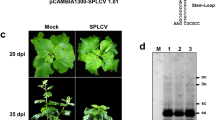Abstract
Momordica charantia (Cucurbitaceae), a vegetable crop commonly cultivated throughout Pakistan, and begomoviruses, a serious threat to crop plants, are natives of tropical and subtropical regions of the world. Leaf samples of M. charantia with yellow vein symptoms typical of begomovirus infections and samples from apparently healthy plants were collected from areas around Lahore in 2004. Full-length clones of a bipartite begomovirus were isolated from symptomatic samples. The complete nucleotide sequences of the components of one isolate were determined, and these showed the arrangement of genes typical of Old World begomoviruses. The complete nucleotides sequence of DNA A showed the highest nucleotide sequence identity (86.9%) to an isolate of Tomato leaf curl New Delhi virus (ToLCNDV), confirming it to belong to a distinct species of begomovirus, for which the name Bitter gourd yellow vein virus (BGYVV) is proposed. Sequence comparisons showed that BGYVV likely emerged as a result of inter-specific recombination between ToLCNDV and tomato leaf curl Bangladesh virus (ToLCBDV). The complete nucleotide sequence of DNA B showed 97.2% nucleotide sequence identity to that of an Indian strain of Squash leaf curl China virus.

Similar content being viewed by others
References
Ali A, Natsuaki T, Okuda S (2004) Identification and molecular characterization of viruses infecting cucurbits in Pakistan. J Phytopathol 152:677–682
Antignus Y, Lachman O, Pearlsman M, Omer S, Yunis H, Messika Y, Uko O, Koren A (2003) Squash leaf curl geminivirus–a new illegal immigrant from the Western Hemisphere and a threat to cucurbit crops in Israel. Abstracts of presentations made at the 24th Congress of the Israeli Phytopathological Society. Phytoparasitica 31:415
Argüello-Astorga GR, Ruiz-Medrano R (2001) An iteron-related domain is associated to motif 1 in the replication proteins of geminiviruses: identification of potential interacting amino acid-base pairs by a comparative approach. Arch Virol 146:1465–1485
Argüello-Astorga GR, Guevara-González LR, Herrera-Estrella LR, Rivera-Bustamante RF (1994) Geminivirus replication origins have a group-specific organization of iterative elements: a model for replication. Virol 203:90–100
Bull SE, Tsai W-S, Briddon RW, Markham PG, Stanley J, Green SK (2004) Diversity of begomovirus DNA β satellites of non-malvaceous plants in east and south east Asia. Arch Virol 149:1193–1200
Doyle JJ, Doyle JL (1990) Isolation of plant DNA from fresh tissue. Focus 12:13–15
Fauquet CM, Bisaro DM, Briddon RW, Brown JK, Harrison BD, Rybicki EP, Stenger DC, Stanley J (2003) Revision of taxonomic criteria for species demarcation in the family Geminiviridae, and an updated list of begomovirus species. Arch Virol 148:405–421
Fauquet CM, Briddon RW, Brown JK, Moriones E, Stanley J, Zerbini M, Zhou X (2008) Geminivirus strain demarcation and nomenclature. Arch Virol 153:783–821
Fontes EPB, Eagle PA, Sipe PS, Luckow VA, Hanley-Bowdoin L (1994) Interaction between a geminivirus replication protein and origin DNA is essential for viral replication. J Biol Chem 269:8459–8465
Heydarnejad J, Mozaffari A, Massumi H, Fazeli R, Gray A, Meredith S, Lakay F, Shepherd D, Martin D, Varsani A (2009) Complete sequences of tomato leaf curl Palampur virus isolates infecting cucurbits in Iran. Arch Virol 154:1015–1018
Hussain M, Mansoor S, Iram S, Zafar Y, Briddon RW (2004) First report of Tomato leaf curl New Delhi virus affecting chilli pepper in Pakistan. Plant Pathol 53:794
Ilyas M, Qazi J, Mansoor S, Briddon RW (2010) Genetic diversity and phylogeography of begomoviruses infecting legumes in Pakistan. J Gen Virol 91:2091–2101
Kheyr-Pour A, Bananej K, Dafalla GA, Caciagli P, Noris E, Ahoonmanesh A, Lecoq H, Gronenborn B (2000) Watermelon chlorotic stunt virus from Sudan and Iran: sequence comparisons and identification of a whitefly-transmission determinant. Phytopathology 90:629–635
Mansoor S, Hussain M, Khan SH, Bashir A, Leghari AB, Panwar GA, Siddiqui WA, Zafar Y, Malik KA (1998) Polymerase chain reaction-based detection of cotton leaf curl and other whitefly-transmitted geminiviruses from Sindh. Pakistan J Biol Sci 1:39–43
Mansoor S, Khan SH, Hussain M, Mushtaq N, Zafar Y, Malik KA (2000) Evidence that watermelon leaf curl disease in Pakistan is associated with Tomato leaf curl virus-India, a bipartite begomovirus. Plant Dis 84:102
Maruthi MN, Rekha AR, Muniyappa V (2007) Pumpkin yellow vein mosaic disease is caused by two distinct begomoviruses: complete viral sequences and comparative transmission by an indigenous Bemisia tabaci and the introduced B-biotype. EPPO Bulletin 37:412–419
Nawaz-ul-Rehmana MS, Nahida N, Mansoor S, Briddon RW, Fauquet CM (2010) Post-transcriptional gene silencing suppressor activity of the alpha-Rep of non-pathogenic alphasatellites associated with begomoviruses. Virology 405:300–308
Page RDM (1996) TREEVIEW: An application to display phylogenetic trees on personal computers. Comput Appl Biosci 12:357–358
Revill PA, Ha CV, Porchun SC, Vu MT, Dale JL (2003) The complete nucleotide sequence of two distinct geminiviruses infecting cucurbits in Vietnam. Arch Virol 148:1523–1541
Rice P, Longden I (2000) A Bleasby 2000 EMBOSS: the European Molecular Biology Open Software Suite. Trends Genet 16:276–277
Tahir M, Haider MS, Briddon RW (2010) First report of Squash leaf curl China virus in Pakistan. Australas Plant Dis Notes 5:21–24
Tsai WS, Shih SL, Green SK, Jan F-J (2007) Occurrence and molecular characterization of Squash leaf curl Phillipines virus in Taiwan. Plant Dis 91:907
Author information
Authors and Affiliations
Corresponding author
Electronic supplementary material
Below is the link to the electronic supplementary material.
Rights and permissions
About this article
Cite this article
Tahir, M., Haider, M.S. & Briddon, R.W. Complete nucleotide sequences of a distinct bipartite begomovirus, bitter gourd yellow vein virus, infecting Momordica charantia . Arch Virol 155, 1901–1905 (2010). https://doi.org/10.1007/s00705-010-0819-5
Received:
Accepted:
Published:
Issue Date:
DOI: https://doi.org/10.1007/s00705-010-0819-5




